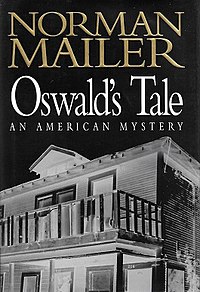Oswalds Tale
by Norman Mailer
The book includes an exhaustive examination of Oswald's movements over the years, and particularly in the months, leading up to Kennedy's assassination on November 22, 1963, and Oswald's own death two days later. Knitted into the story of Oswald's life are Mailer's suppositions on his state of mind and motivations. The Oswald that Mailer depicts is a single-minded and vain individual convinced of his own destiny and importance who suffers a series of defeats and frustrations, and who killed the President in a desperate search for achievement.
When Oswald returns to Dallas in 1963 with his wife and daughter, he still has dreams, still sees himself as "an instrument of history," and is still frustrated and unhappy. His April 1963 assassination attempt on General Edwin Walker, a John Birch Society supporter, shows him acting out his belief that he is an instrument of history in the months leading up to November 22, 1963.
Six months after the assassination attempt on Walker, Oswald takes advantage of the accident of history that has brought the JFK motorcade past the window of the Depository where he works, and he acts out his self-declared destiny.
